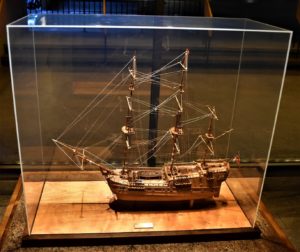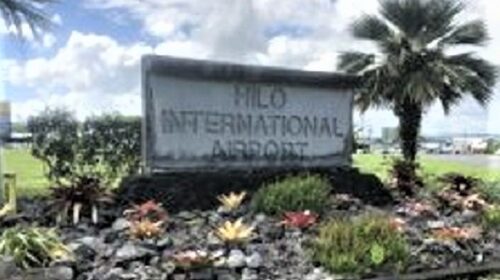I live in a museum: Life as a snowbird in Waikiki’s Discovery Bay
By Dr. Anton Anderssen
On the mainland, when the groundhog sees his shadow, there are six more weeks of winter on the horizon. In Hawaii, when the flamingo sees his shadow, there are six more weeks of paradise – especially for us snowbirds who live here from Christmas to Easter. It took 39 visits to Hawaii to figure out the right place to live as a seasonal tourist. We explored all the major islands before deciding Oahu was the right choice. As much as I love the tropics, I can’t give up cultural gems like the theatre, opera, symphony, fine arts, and historical lectures. Originally, I had my eye on Naalehu (on the Big Island), where Mark Twain planted a monkeypod tree near the southern-most point in the US. Unfortunately, I have muscular dystrophy, and Naalehu is too far from MD specialists.
Oahu has Queen’s Hospital, where board-certified neurologists provide medical services for disabled people like me. At first, I had my eye on Laie town, because I wanted to live near the Mormons. I feel safe with them, most likely due to their prohibitions on stealing, drinking, incivility, and all manner of vices. One never sees drunk panhandlers disturbing the peace, nor drug addicts passed out on their lawns. Although I am not Mormon, I get along with them very well, just as I did when I lived in Amish territory in northcentral Indiana.
I love the Polynesian Cultural Center at Laie. My post-doctorate graduate degree is in cultural anthropology, and visiting the Center is like being a kid in a candy store. I would live there if I could, mingling among the heritage interpreters, celebrating the rich cultures of Polynesia. But again, Laie town is simply too far away from advanced emergency room locations.
After five years, I knew the best match for me was Waikiki; I’m only minutes away from Queen’s Hospital, Blaisdell Concert Hall, free hula shows at Kuhio Beach and International Market Place, Friday night fireworks, and ample public transportation. Finally, I discovered the perfect snowbird home at Discovery Bay, a non-profit-association complex of twin sky scrapers. The edifice is only two bus stops away from Ala Moana Shopping Center, is 100% handicap friendly, plus has a unique feature: quality displays celebrating Hawaiian culture. The word “museum” is defined as a building in which objects of historical, scientific, artistic, or cultural interest are stored and exhibited.
Discovery Bay leases retail space at street level, provides several floors of assigned, covered parking for residents, and then there are the iconic twin towers – Endeavour and Resolution – named after the ships commanded by the famous British explorer Captain James Cook, who “discovered” Hawaii on January 18, 1778. Not everyone has heard this captain’s name before, but more likely are acquainted with the name Captain James Kirk, from Star Trek. Kirk is the fictionalized persona of Cook, whose journal entry “ambition leads me … farther than any other man has been before me” was reiterated on the classic television show as “to explore strange new worlds, to seek out new life and new civilizations, to boldly go where no man has gone before.”
Cook and his crew were greeted with aloha by the Hawaiians; the Polynesians were fascinated by the Europeans’ ships and their use of iron. Hawaiians had a few metal daggers and skewers in their possession when Captain Cook arrived (although iron ore did not originate from these lava-derived islands) apparently some nails had washed ashore, embedded in ship wreckage flotsam. Hawaiians learned how to forge nails into useful objects, despite essentially living in a stone-age era. Discovery Bay’s towers are built from iron alloys and concrete, and if you didn’t know, common ingredients in concrete include seashells and sand – now that’s Hawaiian!
Discovery Bay’s sister lobbies celebrate the discovery of the Hawaiian people. On July 3, 1977, the Honolulu Advertiser wrote, “According to Sanford Murata, designer of the lobby projects, artists were sought to execute commissions in a cross-section of styles and media which would complement not only the environment but each other as well. Reiko Brandon’s ‘Ahu ‘ula’ weaving in Resolution Tower is a bright and bold translation of a traditional Hawaiian feather cape into a modern fiber sculpture. Edna Lau Chen’s ‘Nuuanu Ridge’ oil collage provides a cool counterpoint and transition to the classic forms of Yvonne Cheng’s ‘Hawaiian Women’ batik painting. Randy Hokushin’s three-piece ‘Ceramic Pot Composition’ features strong, elegant sculpture in the deceptively understated medium of raku.”
Dominating the Endeavour lobby is a magnificent oil painting by Pegge Hopper. This revered artist studied painting in Los Angeles, lived in Milano, Italy, working as an illustrator, then moved to Honolulu in 1963, where she worked as an art director for a Hawaiian agency. It was a visit to the state archives that would change everything – she found old photographs of native Hawaiians and was inspired to start painting. Her 1977 oil on canvas on display at Discovery Bay, of a reclining Hawaiian wahine, is dominated by shades of magenta, the iconic color of dendrobian orchids famously sewn into leis and given to visitors as a sign of aloha. The magic of this creation of art is that no two people see it in the exact same way because of its dominant color purple (officially called magenta). We have three types of color cones in our eyes: blue, green, and red. When we see color, our brain knows we must be looking at a color between red and blue, but with the absence of green, our brains invent a perception of purple for us. Purple does not have a wavelength; your brain will decide how you perceive Pegge Hopper’s reclining woman, and it will be unique to you. For a more scientific explanation, see Albert W. Stern’s video, “Why The Color Purple Does Not Really Exist.”
Libby Platus is featured alongside Pegge Hopper with a fiber sculpture entitled “Have You Been to Hanauma Bay?” The Honolulu Advertiser wrote, “… her unique constructions rely upon a system of cross-tension knotting that supports the pieces from within. An articulate and energetic self-taught artist, she views her work as physical gestures frozen in fiber, translations of internal mascular awareness, and external movement into outer form. Like Degas, she draws inspiration from the dance.”
Discovery Bay was the brain-child of Donald Houston Graham, Jr., who was also the developer and contractor for Ala Moana Shopping Center – easily seen from the skyscraper’s Endeavour tower. Graham was born in Oakland, California, on June 14, 1914. He graduated from the University of California-Berkeley and became a bond trader before joining the army and serving in an amphibious unit during World War II. The army awarded Graham two bronze stars for service in the Philippine battles of Leyte and Lingayan. Graham also was present in Tokyo for the signing of the treaty with Japan to end the war.
Graham’s affinity for James Cook, the famous historical captain in the Royal Navy who explored the Pacific, was undoubtedly spurred by his own experiences in amphibious warfare in the Pacific. Graham’s military assignments took him to places explored and mapped by Cook; he must have held Captain Cook in high esteem to name the magnificent skyscrapers and retail complex in Cook’s honor. On the main floor of Endeavour tower is a showcase holding a replica of Cook’s ship HMS Endeavour, created by artist Robert P Silverstein (1974). The Resolution tower has a similar showcase with a scale model of the HMS Resolution, in which Captain James Cook discovered the Hawaiian islands. What is remarkable about these two works of art is that they were commissioned in 1974, but the Declaration of Horizontal Property Regime for Discovery Bay was dated November 11, 1975 – as if Discovery Bay were designed around the two ships as a monument to them. It’s also interesting that Graham filed his paperwork on Veteran’s Day, a further honor to Cook, a captain in the Royal Navy.
Discovery Bay rests on several parcels of land, so Graham had a choice in which address he wanted to use. He chose Ala Moana for the street, although he could have claimed Hobron or Kaio’o. Ala Moana runs along the ocean in Honolulu and translates as “path to the ocean;” Cook discovered Oahu while sailing a path across the ocean. If there had been modern streets on Oahu during Cook’s voyage, it most likely would have been called some version of “Ala Moana.” Graham chose 1778 as his street number for the twin skyscrapers – the year Captain Cook discovered Hawaii. The building is a magnificent symbol of discovery, indeed.
Elevators zipping up and down the skyscrapers are decorated with tiles commemorating Cook’s visit to the islands; hallways fronting elevator doors are similarly designed with historic drawings and maps. Cook was a cartographer – there are images created by Captain Cook himself (including an autograph). Above the guard station in Endeavour tower, a horizontal print depicts warriors traveling in canoes – perhaps the first to meet Cook upon his arrival.
The lobbies contain other gems, too, such as an old photograph of the Royal Hawaiian hotel taken in 1928, and a view of Aliiolani Hale taken from the top of Iolani Palace, back when Honolulu Harbor came all the way up to Queen Street.
I did have reservations about moving in to such a large condominium. One of my long-time work colleagues is the president of his own condo association. He told me horror stories about never-ending problems with grumbletonians: at the condo meetings, people would scream and threaten each other endlessly – until the wee hours of the morning. Civility was cast aside. Albeit with trepidation, I went to our annual association meeting just weeks after moving in; I found something more like a luau than the night of living Hell. There were no brawls. There was no caterwauling. There was no expostulating. Instead, there was a lavish buffet and cheerful residents mingling with each other. After the sumptuous feast, John Stewart (President of the Board of Directors) welcomed the guests and began telling us good news about the future of the complex. Since no one had any complaints, he said, “If you have any problems, just talk to me – I’ll listen.” The meeting ran like a well-oiled machine; it was completed in about 40 minutes. Afterwards, some residents stayed around and discussed how much they loved John Stewart and the management team. Then some residents said, “Hey, let’s all go out for cocktails.”
I have been impressed with management from day one. I have muscular dystrophy and am disabled. There are actually four disabled people on my floor. I bought this condo because I thought it was the most handicap-friendly building in my price range in all of Waikiki. At some point, I am going to be confined to my wheelchair full time; right now, I never know if I can walk 100 feet or if I can’t walk at all when I awake in the morning. Management has made it a joy to live in these skyscrapers. They told the guards to look out for me, and any time guards see me coming or going from the lobby, they get up and open the doors.
The non-profit Home Owners’ Association is run by amazing people! Chris Herndon is named on two awards displayed near the management office: IREM 2013 Building of the Year (High Rise over 350 units) in recognition for providing outstanding housing environment, and IREM 2014 Accredited Residential Manager Member of the Year (High Rise over 450 units). A third display recognizes William Samaritano’s award as IREM’s 2015 Accredited Residential Manager Member of the Year (High Rise over 450 units). One day a large, heavy case of computer paper came for me, and I had no idea how to get it up to my condo. Chris Herndon picked it up, lugged it to my condo, and brought it inside for me. That was just one example of his kindness and aloha for the disabled. The residents sing his praises all the time.
The building is kept meticulously clean. They use scrubbing machines to clean the concrete around the pools, they have gardeners tending to the tropical plants about the building, the lobby is so clean you could eat off the floors. A staff of 35 keep the Resolution and Endeavour in shipshape, as it were.
Thanks to La’akea Frias, this building has presidential-quality security. There are hundreds of cameras everywhere, and La’akea memorizes who the residents are. He runs a tight ship, and at the same time is warm and polite. You can’t ask for anything better. I saw him one day rescuing a disabled lady who lives on my floor; he and a second security guard were able to get to her because they have master keys for emergencies. They have a program in place to help disabled people during an emergency; all you have to do is notify management, and they will come to your aid in those rare circumstances.
They guard the residents in the same way a museum guards its artefacts. They make us feel treasured and, especially for people like me, provide an environment where I can live with dignity, despite my disability.
I’ve worked at several museums before; I’m in the docent program at Iolani Palace, and I love cultural enrichment. Living here is like living in a museum; every day I am thankful to live in paradise, in these beautiful skyscrapers, where so much cultural heritage is integrated into the environment. I am living a charmed life.
Follow the author, Anton Anderssen, at facebook.com/ILoveAnton




